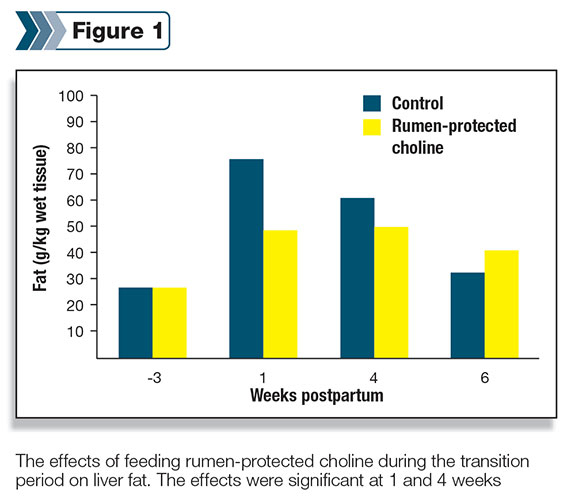The last publication of the Nutrient Requirements of Dairy Cattle did not include choline as a required nutrient for dry or lactating cows, citing the need for more research. Since that publication, there has been considerable research on choline for dairy cows, including 13 university studies focusing on transition cows.
In total, these studies make a compelling argument that choline should be listed as a required nutrient during the periparturient period.
In every species that it has been studied, the classic choline deficiency symptom is fatty liver. In nonruminants it has been clearly shown that choline, as a constituent of phosphytidylcholine, is required for export of fat out of the liver as very low-density lipoproteins (VLDL).
Due to extensive mobilization of fatty acids from adipose tissue and subsequent uptake by the liver, approximately 50 percent of transition dairy cows will develop what the veterinary community describes as moderate to severe fatty liver at parturition or soon after.
Ketosis or subclinical ketosis occurs in approximately 40 to 60 percent of fresh cows and is typically secondary to development of fatty liver.
Not only do transition cows show the classic deficiency symptom for choline, research over the past decade has indicated that feeding rumen-protected choline can reduce fat accumulation in the liver and the incidence of ketosis.
This probably occurs by alleviating a choline deficiency because unprotected choline in feeds is extensively degraded by micro-organisms in the rumen and very little dietary choline reaches the lower gut for absorption.
The mechanisms by which choline prevents fatty liver has been extensively studied and is well documented for nonruminants, and it has been assumed that similar mechanisms occur in dairy cows.
An exciting new field of research referred to as nutritional genomics allowed scientists at UR Livestock Research to examine how choline affects the expression of genes important to metabolism in adipose tissue and liver of transition dairy cows.
Their findings have established that the dairy cow is in fact similar to nonruminants in that choline has a direct effect on processes important for fat transport out of the liver.
Sixteen multiparous Holstein Friesian dairy cows in good body condition (mean = 3.25) and not experiencing subclinical ketosis were fed 60 g of a choline source per day or a control diet from three weeks prior to calving until six weeks postcalving.
The source of choline provides 15 g per day of choline in a form that is protected from degradation in the rumen. Liver and adipose tissue were sampled at three weeks prior to calving and at one, three and six weeks postpartum.

Using real-time quantitative PCR (polymerase chain reaction), gene expression of key enzymes involved in fatty acid and energy metabolism were measured.
The first important finding from this research was confirmation that feeding rumen-protected choline to transition cows significantly reduced liver fat at one and four weeks postpartum ( Figure 1 ).
Feeding a source of choline did not affect adipose tissue gene expression of enzymes controlling fat metabolism in adipose tissue.
This suggests that choline does not reduce liver

fat by reducing fatty acid mobilization from adipose tissue and subsequent NEFA uptake by the liver.
Cows fed the source of choline showed greater gene expression of liver microsomal triglyceride transfer protein (MTTP; Figure 2 ).
MTTP functions at the endoplasmic reticulum of the liver cell and is required for packaging fat into a VLDL and secreting it from the liver.
The elevated MTTP suggests that supplementing choline facilitates fat export out of the liver and helps the transition cow cope with elevated fatty acid uptake by the liver.
Choline supplementation increased liver gene expression of apolipoprotein B100, a constituent of VLDL that is also required for VLDL secretion.
This also suggests that VLDL fat export is enhanced when improving the choline status of transition cows.
Although expression of genes involved in phosphatidylcholine synthesis was not measured in this study, increased synthesis possibly could have been involved in triggering the expression of genes coding for MTTP and apolipoprotein B100 synthesis.
Interestingly, expression of genes related to glucose production was also affected by feeding the source of choline. Previous research indicated that the source of choline increased glucose storage, as glycogen in the liver and liver cells with lower fat content have higher rates of glucose synthesis.
Ruminants absorb very little glucose from the gastrointestinal tract and are highly dependent on the liver to synthesize glucose. Glucose is the precursor for lactose synthesis by the mammary gland. Lactose production is the primary determinant for volume of milk produced.
Substantial evidence indicates that feeding choline affects transition cows at the “whole animal” level (e.g., enhances milk production and health).
Additionally, previous research indicates that feeding choline affects transition cows at the “organ level,” e.g., reduces liver fat and increases liver glycogen during the periparturient period.
The current study from UR Livestock Research provides the first evidence that feeding choline affects transition cows at the “molecular level.” The effects observed at the molecular level are very consistent with previous observations at the organ or whole animal level.
Choline-enhanced expression of genes involved in VLDL assembly and secretion correlates with lower liver fat content; alteration of genes involved with glucose metabolism correlates with higher liver glycogen content and enhanced milk production.
This new research provides additional evidence that choline is an essential nutrient that should be supplemented to transition cows. PD
Grummer is also an emeritus professor in the Department of Dairy Science at the University of Wisconsin – Madison.
References omitted due to space but are available upon request. Click here to email an editor.










